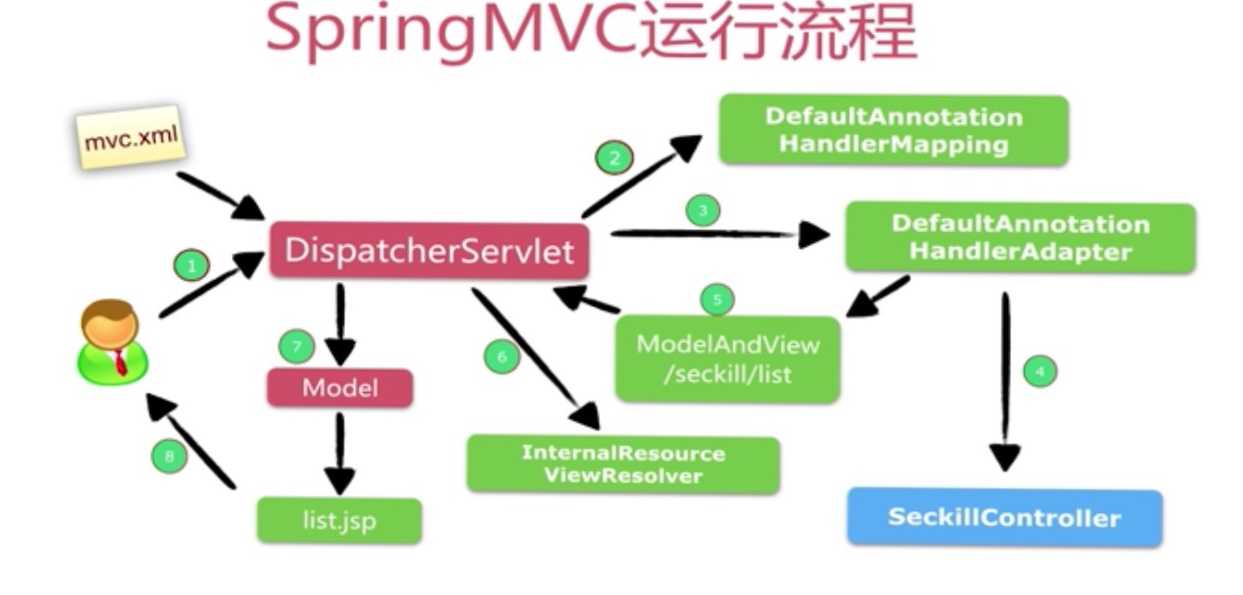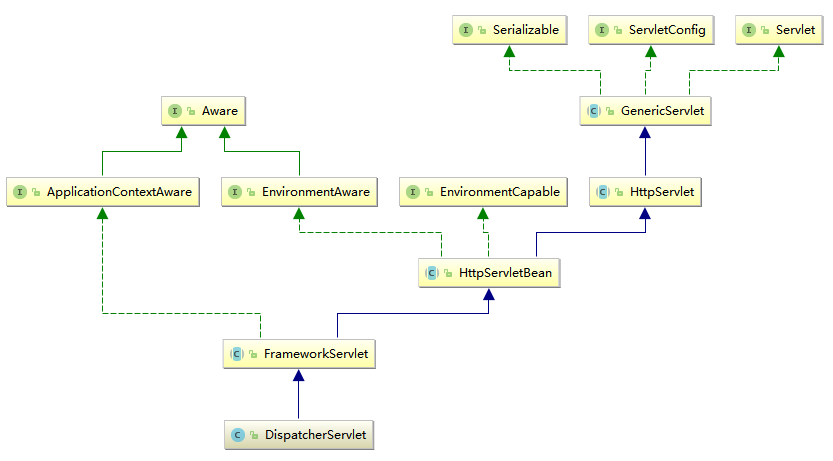一、SpringMVC的主要组件
- 前端控制器(DisatcherServlet):接收请求,响应结果,返回可以是json,String等数据类型,也可以是页面(Model)。
- 处理器映射器(HandlerMapping):根据URL去查找处理器,一般通过xml配置或者注解进行查找。
- 处理器(Handler):就是我们常说的controller控制器啦,由程序员编写。
- 处理器适配器(HandlerAdapter):可以将处理器包装成适配器,这样就可以支持多种类型的处理器。
- 视图解析器(ViewResovler):进行视图解析,返回view对象(常见的有JSP,FreeMark等)。
二、SpingMVC的工作原理

步骤说明:
1、用户发送请求到前端控制器(DispatcherServlet)。
2、前端控制器请求处理器映射器(HandlerMapping)去查找处理器(Handler)。
3、找到以后,处理器映射器(HandlerMappering)向前端控制器返回执行链(HandlerExecutionChain)。
4、前端控制器(DispatcherServlet)调用处理器适配器(HandlerAdapter)去执行处理器(Handler)。
5、处理器适配器去执行Handler。
6、处理器执行完给处理器适配器返回ModelAndView。
7、处理器适配器向前端控制器返回ModelAndView。
8、前端控制器请求视图解析器(ViewResolver)去进行视图解析。
9、视图解析器向前端控制器返回View。
10、前端控制器对视图进行渲染。
11、前端控制器向用户响应结果。
三、实现原理

DispatcherServlet动作大致可以分为两个部分:初始化部分和对Http的请求进行响应
1. 初始化:
HttppServletBean.init()---->FrameworkServlet.initServletBean()
---->initWebApplicationContext()
---->DispatcherServlet.onRefresh()
---->initStrategies()
protected void initStrategies(ApplicationContext context) {
//初始化多媒体解析器
initMultipartResolver(context);
//初始化位置解析器
initLocaleResolver(context);
//初始化主题解析器
initThemeResolver(context);
//初始化HandlerMappings
initHandlerMappings(context);
// 初始化HandlerAdapters
initHandlerAdapters(context);
//初始化异常解析器
initHandlerExceptionResolvers(context);
//初始化请求到视图名转换器
initRequestToViewNameTranslator(context);
//初始化视图解析器
initViewResolvers(context);
//初始化FlashMapManager
initFlashMapManager(context);
}
2. 对Http的请求进行响应
作为一个Servlet,web容器会调用Servlet的doGet()和doPost()方法,在经过FrameServlet的processRequest()简单处理后,会调用DispatcherServlet的doService()方法,在这个方法中封装了doDispatch()。
doDispatch方法
protected void doDispatch(HttpServletRequest request, HttpServletResponse response) throws Exception {
HttpServletRequest processedRequest = request;
HandlerExecutionChain mappedHandler = null;
boolean multipartRequestParsed = false;
WebAsyncManager asyncManager = WebAsyncUtils.getAsyncManager(request);
try {
ModelAndView mv = null;
Exception dispatchException = null;
try {
processedRequest = checkMultipart(request);
multipartRequestParsed = (processedRequest != request);
// Determine handler for the current request.
mappedHandler = getHandler(processedRequest); //查找handler及其拦截器
if (mappedHandler == null || mappedHandler.getHandler() == null) {
noHandlerFound(processedRequest, response);
return;
}
// Determine handler adapter for the current request.
HandlerAdapter ha = getHandlerAdapter(mappedHandler.getHandler()); //查找handler的适配器
// Process last-modified header, if supported by the handler.
String method = request.getMethod();
boolean isGet = "GET".equals(method);
if (isGet || "HEAD".equals(method)) {
long lastModified = ha.getLastModified(request, mappedHandler.getHandler());
if (logger.isDebugEnabled()) {
logger.debug("Last-Modified value for [" + getRequestUri(request) + "] is: " + lastModified);
}
if (new ServletWebRequest(request, response).checkNotModified(lastModified) && isGet) {
return;
}
}
if (!mappedHandler.applyPreHandle(processedRequest, response)) {
return;
}
// Actually invoke the handler.
mv = ha.handle(processedRequest, response, mappedHandler.getHandler()); //通过适配器执行handler,并返回ModelAndView对象
if (asyncManager.isConcurrentHandlingStarted()) {
return;
}
applyDefaultViewName(processedRequest, mv);
mappedHandler.applyPostHandle(processedRequest, response, mv);
}
catch (Exception ex) {
dispatchException = ex;
}
catch (Throwable err) {
// As of 4.3, we're processing Errors thrown from handler methods as well,
// making them available for @ExceptionHandler methods and other scenarios.
dispatchException = new NestedServletException("Handler dispatch failed", err);
}
processDispatchResult(processedRequest, response, mappedHandler, mv, dispatchException);
}
catch (Exception ex) {
triggerAfterCompletion(processedRequest, response, mappedHandler, ex);
}
catch (Throwable err) {
triggerAfterCompletion(processedRequest, response, mappedHandler,
new NestedServletException("Handler processing failed", err));
}
finally {
if (asyncManager.isConcurrentHandlingStarted()) {
// Instead of postHandle and afterCompletion
if (mappedHandler != null) {
mappedHandler.applyAfterConcurrentHandlingStarted(processedRequest, response);
}
}
else {
// Clean up any resources used by a multipart request.
if (multipartRequestParsed) {
cleanupMultipart(processedRequest);
}
}
}
}
HandlerExecutionChain的属性
public class HandlerExecutionChain { private static final Log logger = LogFactory.getLog(HandlerExecutionChain.class); private final Object handler; private HandlerInterceptor[] interceptors; private List<HandlerInterceptor> interceptorList; private int interceptorIndex = -1;
}